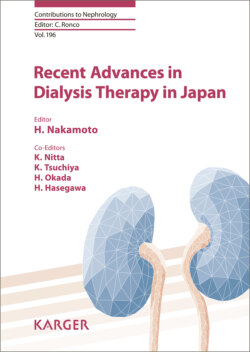Читать книгу Recent Advances in Dialysis Therapy in Japan - Группа авторов - Страница 11
На сайте Литреса книга снята с продажи.
Expectations and Challenges of PD Therapy
ОглавлениеPD therapy fills patient’s peritoneal cavity with dialysate and lets the peritonea (media tissue) work as semipermeable membrane to allow water level management (ultrafiltration) and solute removal (diffusion) [2]. Because PD can be practiced at home to fit each patient’s circumstances, it wins higher satisfaction, and is expected to further prevail as a favorable treatment option. However, it also involves (1) technical stress of self-management; (2) repeated inflammation, caused by long-lasted chemical strain, such as composition and pH, or infection, leading to peritoneal deterioration, which may sequentially trigger degeneration, fibrosis, and capsular formation, and eventually lead to encapsulating peritoneal sclerosis (EPS), which can cause a life-threatening complication of intestinal obstruction; and (3), less effective penetration related to increased peritoneal permeability due to peritoneal deterioration [3]. These are considered to be the cause of sluggish growth of PD introduction rate [4]. Since 1978, PD has been practiced across the world, and has continuously been improved with an aim to reduce complications and enhance the dialysis efficiency. The keyword for improvement of PD solution has long been “biological compatibility.” Although improved PD solution helped to decrease the occurrence of EPS, it has yet to control it [5]. Reports from Europe and the US, however, value PD more than hemodialysis, which is widely used in Japan, as a renal replacement therapy for patients with terminal renal failure, in terms of quality of life and medical expenses [6]. In Japan, medical cost is becoming a major issue as the dialysis patients age. Study results [7] indicate that if the number of patients receiving PD therapy increases, medical cost will be lowered and the quality of medical care will be enhanced. Therefore, increased uptake of PD will have a great significance both medically and economically [8]. PD will help promote rehabilitation of patients, especially for those in economically productive age group trying to rejoin their company or get a job. As a result, it is expected that the labor-force participation ratio will increase [9], and patients will be able to work to support themselves, make tax payments, reduce the burden of people around them, and lead a healthy social life.
